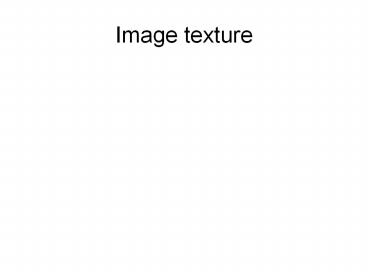Image texture - PowerPoint PPT Presentation
Title:
Image texture
Description:
Image texture – PowerPoint PPT presentation
Number of Views:63
Avg rating:3.0/5.0
Title: Image texture
1
Image texture
2
Texture
- Key issue representing texture
- Texture based matching
- little is known
- Texture segmentation
- key issue representing texture
- Texture synthesis
- useful also gives some insight into quality of
representation - Shape from texture
- cover superficially
3
The Goal of Texture Synthesis
input image
SYNTHESIS
True (infinite) texture
generated image
- Given a finite sample of some texture, the goal
is to synthesize other samples from that same
texture - The sample needs to be "large enough
4
The Goal of Texture Analysis
input image
Same or different
ANALYSIS
True (infinite) texture
generated image
- Compare textures and decide if theyre made of
the same stuff.
5
Pre-attentive texture discrimination
6
Pre-attentive texture discrimination
7
Pre-attentive texture discrimination
Same or different textures?
8
Pre-attentive texture discrimination
9
Pre-attentive texture discrimination
10
Pre-attentive texture discrimination
Same or different textures?
11
Julesz
- Textons analyze the texture in terms of
statistical relationships between fundamental
texture elements, called textons. - It generally required a human to look at the
texture in order to decide what those fundamental
units were...
12
Influential paper
13
Bergen and Adelson, Nature 1988
Learn use filters.
14
Malik and Perona
Learn use lots of filters, multi-oriscale.
Malik J, Perona P. Preattentive texture
discrimination with early vision mechanisms. J
OPT SOC AM A 7 (5) 923-932 MAY 1990
15
Representing textures
- Textures are made up of quite stylised
subelements, repeated in meaningful ways - Representation
- find the subelements, and represent their
statistics - But what are the subelements, and how do we find
them? - recall normalized correlation
- find subelements by applying filters, looking at
the magnitude of the response
- What filters?
- experience suggests spots and oriented bars at a
variety of different scales - details probably dont matter
- What statistics?
- within reason, the more the merrier.
- At least, mean and standard deviation
- better, various conditional histograms.
16
(No Transcript)
17
image
18
(No Transcript)
19
(No Transcript)
20
(No Transcript)
21
SIGGRAPH 1994
22
Bergen and Heeger
Learn use filter marginal statistics.
23
Bergen and Heeger results
24
Bergen and Heeger failures
25
De Bonet (and Viola)
SIGGRAPH 1997
26
DeBonet
Learn use filter conditional statistics across
scale.
27
DeBonet
28
DeBonet
29
Portilla and Simoncelli
- Parametric representation.
- About 1000 numbers to describe a texture.
- Ok results maybe as good as DeBonet.
30
Portilla and Simoncelli
31
Zhu, Wu, Mumford, 1998
- Principled approach.
- Synthesis quality not great, but ok.
32
Zhu, Wu, Mumford
- Cheetah Synthetic
33
(No Transcript)
34
Efros and Leung
35
(No Transcript)
36
What weve learned from the previous texture
synthesis methods
- From Adelson and Bergen
- examine filter outputs
- From Perona and Malik
- use multi-scale, multi-orientation filters.
- From Heeger and Bergen
- use marginal statistics (histograms) of filter
responses. - From DeBonet
- use conditional filter responses across scale.
37
What we learned from Efros and Leung regarding
texture synthesis
- Dont need conditional filter responses across
scale - Dont need marginal statistics of filter
responses. - Dont need multi-scale, multi-orientation
filters. - Dont need filters.
38
Efros Leung 99
- The algorithm
- Very simple
- Surprisingly good results
- Synthesis is easier than analysis!
- but very slow
- Optimizations and Improvements
- Wei Levoy,00 (based on Popat Picard,93)
- Harrison,01
- Ashikhmin,01
39
Efros Leung 99 extended
non-parametric sampling
Input image
- Observation neighbor pixels are highly correlated
40
Image QuiltingEfros and Freeman 2001
- Idea
- lets combine random block placement of Chaos
Mosaic with spatial constraints of Efros Leung - Related Work (concurrent)
- Real-time patch-based sampling Liang et.al. 01
- Image Analogies Hertzmann et.al. 01
41
block
Input texture
B1
B2
Random placement of blocks
42
Minimal error boundary
overlapping blocks
vertical boundary
43
Our Philosophy
- The Corrupt Professors Algorithm
- Plagiarize as much of the source image as you can
- Then try to cover up the evidence
- Rationale
- Texture blocks are by definition correct samples
of texture so problem only connecting them
together
44
Algorithm
- Pick size of block and size of overlap
- Synthesize blocks in raster order
- Search input texture for block that satisfies
overlap constraints (above and left) - Easy to optimize using NN search Liang et.al.,
01 - Paste new block into resulting texture
- use dynamic programming to compute minimal error
boundary cut
45
(No Transcript)
46
(No Transcript)
47
(No Transcript)
48
(No Transcript)
49
(No Transcript)
50
(No Transcript)
51
(No Transcript)
52
Failures (Chernobyl Harvest)
53
Texture Transfer
- Take the texture from one object and paint it
onto another object - This requires separating texture and shape
- Thats HARD, but we can cheat
- Assume we can capture shape by boundary and rough
shading
Then, just add another constraint when sampling
similarity to underlying image at that spot
54
parmesan
rice
55
56
57
Source texture
Target image
58
59
Portilla Simoncelli
Xu, Guo Shum
input image
Wei Levoy
Image Quilting
60
Portilla Simoncelli
Xu, Guo Shum
input image
Wei Levoy
Image Quilting
61
Homage to Shannon!
Portilla Simoncelli
Xu, Guo Shum
input image
Wei Levoy
Image Quilting
62
Summary of image quilting
- Quilt together patches of input image
- randomly (texture synthesis)
- constrained (texture transfer)
- Image Quilting
- No filters, no multi-scale, no one-pixel-at-a-time
! - fast and very simple
- Results are not bad
63
Advances in Computer Vision
- Spring term, 2009
- Relevant to CS graduate students counts toward
TQE requirements, for AI area - time offered
64
Advances in Computer Vision
65
end































